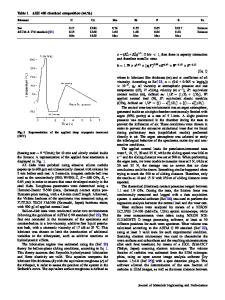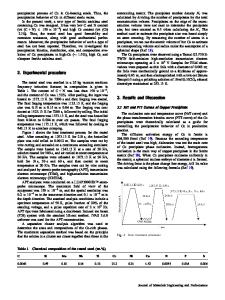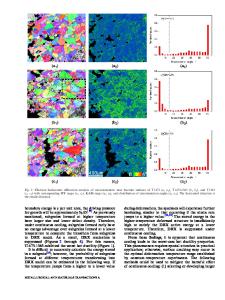Erosion Wear Behavior of Martensitic Stainless Steel Under the Hydro-Abrasive Condition of Hydropower Plants
- PDF / 2,993,011 Bytes
- 11 Pages / 593.972 x 792 pts Page_size
- 13 Downloads / 318 Views
JMEPEG https://doi.org/10.1007/s11665-020-05238-2
Erosion Wear Behavior of Martensitic Stainless Steel Under the Hydro-Abrasive Condition of Hydropower Plants Shubham Sharma and Bhupendra K. Gandhi Submitted: 5 May 2020 / Revised: 22 August 2020 / Accepted: 8 October 2020 The erosive wear of a hydraulic turbine due to suspended solid particles reduces its performance and service life. Martensitic stainless steel CA6NM, used for turbine parts of a hydropower plant, gets eroded heavily every year, particularly in the monsoon period. A high-speed slurry pot tester is employed to investigate the erosion behavior of the material under different operating conditions of practical interest. Scanning electron microscopy (SEM), as well as spark emission spectrometer (SES) and micro-hardness tester measurements, is used to investigate the erosion wear behavior of CA6NM. The impingement velocity is varied from 13 to 32 m/s for the particle size of 90.5–362.5 lm and solid concentration of 500–4000 ppm at different orientation angles ranging from 15° to 90°. The erosion rate for suspension loading is increased with the increase in the impact velocity and particle size but decreased with an increase in suspension concentration. The index value in power-law relationship with erosion rate is found as 2.77 and 3.19 for velocity, and 1.42 and 0.97 for particle size for impingement angle of 30° and 90°, respectively. The micrographic analysis of the eroded sample is performed through a scanning electron microscope (SEM). At shallow impingement angle, the material loss dominantly occurred by micro-cutting and plowing, but at high impact velocity, some spackle of brittle failure is also observed. At large impingement angles, deep craters and crack formation are found responsible for the material loss under the present operating conditions. Keywords
CA6NM, erosive wear, hydro-abrasive condition, suspension loading
failure slurry
mechanism, pot tester,
1. Introduction The material removal by friction and impact of suspended abrasive particles is responsible for the deterioration of flow passages of hydroturbines (Ref 1). Such hydro-abrasive erosion is prominent in both impulse and reaction turbines (Ref 2-4). The erosion of flow passages causes a change in the flow patterns, loss in efficiency, and vibrations, which are responsible for the final breakdown of the turbine (Ref 3-5). Erosion regimes often depend on specific working conditions and material types (Ref 6). Thapa et al. (Ref 5) reported that the erosion of the turbine is a complex phenomenon and depends on several parameters such as abrasive particle size, hardness, concentration, impact velocity, impingement angle, and properties of the target material. Various components of a turbine are susceptible to erosion wear like a needle, nozzle buckets of impulse turbine, and guide vane, faceplate, runner vanes, and labyrinth seals of reaction turbine (Ref 7). The powerplants situated in the Himalayan region are severely affected due to the erosion. For instance, the
Shubham Sharma an
Data Loading...











